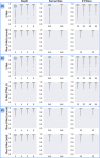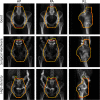Identifying the optimal deep learning architecture and parameters for automatic beam aperture definition in 3D radiotherapy
- PMID: 37670488
- PMCID: PMC10691634
- DOI: 10.1002/acm2.14131
Identifying the optimal deep learning architecture and parameters for automatic beam aperture definition in 3D radiotherapy
Abstract
Purpose: Two-dimensional radiotherapy is often used to treat cervical cancer in low- and middle-income countries, but treatment planning can be challenging and time-consuming. Neural networks offer the potential to greatly decrease planning time through automation, but the impact of the wide range of hyperparameters to be set during training on model accuracy has not been exhaustively investigated. In the current study, we evaluated the effect of several convolutional neural network architectures and hyperparameters on 2D radiotherapy treatment field delineation.
Methods: Six commonly used deep learning architectures were trained to delineate four-field box apertures on digitally reconstructed radiographs for cervical cancer radiotherapy. A comprehensive search of optimal hyperparameters for all models was conducted by varying the initial learning rate, image normalization methods, and (when appropriate) convolutional kernel size, the number of learnable parameters via network depth and the number of feature maps per convolution, and nonlinear activation functions. This yielded over 1700 unique models, which were all trained until performance converged and then tested on a separate dataset.
Results: Of all hyperparameters, the choice of initial learning rate was most consistently significant for improved performance on the test set, with all top-performing models using learning rates of 0.0001. The optimal image normalization was not consistent across architectures. High overlap (mean Dice similarity coefficient = 0.98) and surface distance agreement (mean surface distance < 2 mm) were achieved between the treatment field apertures for all architectures using the identified best hyperparameters. Overlap Dice similarity coefficient (DSC) and distance metrics (mean surface distance and Hausdorff distance) indicated that DeepLabv3+ and D-LinkNet architectures were least sensitive to initial hyperparameter selection.
Conclusion: DeepLabv3+ and D-LinkNet are most robust to initial hyperparameter selection. Learning rate, nonlinear activation function, and kernel size are also important hyperparameters for improving performance.
Keywords: automatic segmentation; cervical cancer; digitally reconstructed radiograph; radiotherapy.
© 2023 The Authors. Journal of Applied Clinical Medical Physics published by Wiley Periodicals, LLC on behalf of The American Association of Physicists in Medicine.
Conflict of interest statement
The authors have no conflicts of interest to disclose.
Figures





Similar articles
-
Clinical Target Volume Auto-Segmentation of Esophageal Cancer for Radiotherapy After Radical Surgery Based on Deep Learning.Technol Cancer Res Treat. 2021 Jan-Dec;20:15330338211034284. doi: 10.1177/15330338211034284. Technol Cancer Res Treat. 2021. PMID: 34387104 Free PMC article.
-
Clinical target volume (CTV) automatic delineation using deep learning network for cervical cancer radiotherapy: A study with external validation.J Appl Clin Med Phys. 2025 Jan;26(1):e14553. doi: 10.1002/acm2.14553. Epub 2024 Oct 14. J Appl Clin Med Phys. 2025. PMID: 39401180 Free PMC article.
-
Automatic clinical target volume delineation for cervical cancer in CT images using deep learning.Med Phys. 2021 Jul;48(7):3968-3981. doi: 10.1002/mp.14898. Epub 2021 May 19. Med Phys. 2021. PMID: 33905545
-
Deep learning in CT image segmentation of cervical cancer: a systematic review and meta-analysis.Radiat Oncol. 2022 Nov 7;17(1):175. doi: 10.1186/s13014-022-02148-6. Radiat Oncol. 2022. PMID: 36344989 Free PMC article.
-
A review of segmentation and deformable registration methods applied to adaptive cervical cancer radiation therapy treatment planning.Artif Intell Med. 2015 Jun;64(2):75-87. doi: 10.1016/j.artmed.2015.04.006. Epub 2015 May 16. Artif Intell Med. 2015. PMID: 26025124 Review.
Cited by
-
Machine and Deep Learning for the Diagnosis, Prognosis, and Treatment of Cervical Cancer: A Scoping Review.Diagnostics (Basel). 2025 Jun 17;15(12):1543. doi: 10.3390/diagnostics15121543. Diagnostics (Basel). 2025. PMID: 40564863 Free PMC article. Review.
-
Exploring the impact of network depth on 3D U-Net-based dose prediction for cervical cancer radiotherapy.Front Oncol. 2024 Sep 16;14:1433225. doi: 10.3389/fonc.2024.1433225. eCollection 2024. Front Oncol. 2024. PMID: 39351348 Free PMC article.
References
-
- Ferlay J, Soerjomataram I, Dikshit R, et al. Cancer incidence and mortality worldwide: Sources, methods and major patterns in GLOBOCAN 2012. Int J Cancer. 2015;136:E359‐E386. - PubMed
-
- International Atomic Energy Agency . Management of cervical cancer: strategies for limited‐resource centres—A guide for radiation oncologists. Saudi Med J. 2013;33:13‐18.

